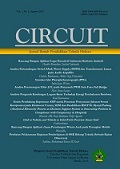Analisis kapasitas dan Imperceptibility Proses Penyisipan Pesan Pada Citra Menggunakan LWT dan Metode BPCS
DOI:
https://doi.org/10.22373/crc.v3i2.5195Keywords:
Lifting Wavelet Transform, Bit-Plane Complexity SegmentationAbstract
Salah satu cara untuk melindungi pesan rahasia dari orang yang tidak berhak mengaksesnya yaitu dengan cara menyisipkan pesan rahasia pada suatu wadah penampung, misalnya citra. Pada penelitian ini akan dievaluasi kapasitas pesan rahasia yang dapat ditampung oleh citra, serta tingkat impercebtibility citra yang telah mengandung pesan rahasia. Pesan rahasia akan disisikan pada daerah koefisien wavelet yaitu koefisien aproksimasi (LL) yang diperoleh dengan melakukan Lifting Wavelet Transform(LWT). Metode yang digunakan untuk meyisipkan bit-bit pesan ke dalam piksel citra yaitu metode Bit-Plane Complexity Segmentation(BPCS). Hasil yang diperoleh pada penelitian ini, citra yang memiliki noise-like tinggi akan memiliki kapasitas yang banyak, akan tetapi tingkat imperceptibility yang kurang.
Downloads
Published
Issue
Section
License
Authors who publish in this journal agree to the following terms:
- Authors retain copyright and grant the journal right of first publication with the work simultaneously licensed under a Creative Commons Attribution License that allows others to share the work with an acknowledgement of the work's authorship and initial publication in this journal.
The Journal uses license CC-BY-SA or an equivalent license as the optimal license for the publication, distribution, use, and reuse of scholarly works.
Authors are able to enter into separate, additional contractual arrangements for the non-exclusive distribution of the journal's published version of the work (e.g., post it to an institutional repository or publish it in a book), with an acknowledgement of its initial publication in this journal.
- Authors are permitted and encouraged to post their work online (e.g., in institutional repositories or on their website) prior to and during the submission process, as it can lead to productive exchanges, as well as earlier and greater citation of published work (See The Effect of Open Access).

